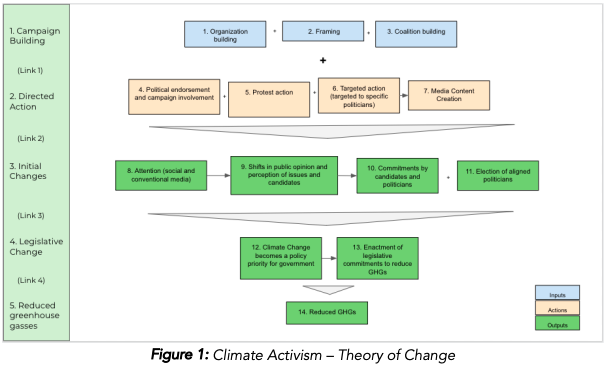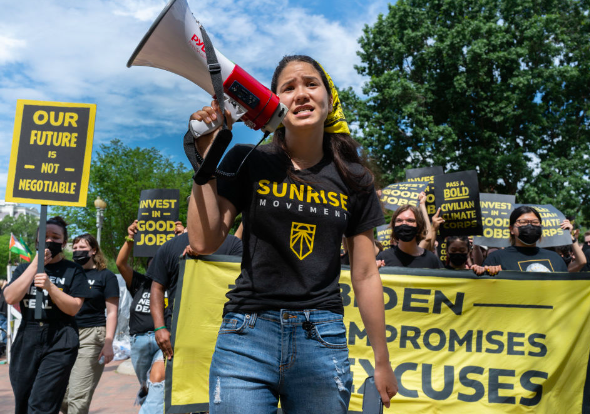Resources
Search below for resources covering the intersection of climate engagement, social science and data analytics.
RESULTS
Social Homes as Sources of Power for Health Equity
Movement organizations invest in 4 common elements to support individual and collective member political transformation and enhance recruitment and retention. These methods include: addressing whole-person needs via culture, community-building, and care; internal accountability and decision-making; political education; and enabling smaller “sub-homes” within the home (i.e., within the organization). Organizations believe they can successfully convert the collective member transformation occurring within their social homes into potential and exercised power over the conditions and policies that create health inequities. Movement organizations are hungry for spaces where they can be in direct dialogue with one another regarding the operationalization and measurement of this work. This report includes case studies on various organizations around the US—on how they’ve aimed to cultivate “social homes” within their constituencies.
Sector Overview: Activism
Activism seeks to change political outcomes by engaging more people in the political process. Climate activism’s theory of change can be broken down into 5 stages: campaign building, directed action, initial changes, legislative change, and reduced greenhouse gases in the atmosphere. There are some competing theories about how to best succeed at any of these stages, such as structure- versus mass-based movement organizing. This report summarizes some academic research on each of these categories.
Resources for working with climate emotions
There are numerous resources for those seeking to better understand climate emotions and those feeling depressed, anxious, or overwhelmed by the climate crisis. Eco-distress is a normal and reasonable feeling in response to the social, environmental, and economic impacts of climate change.
What the Sunrise Movement Can Do Better
Social movements like the Sunrise Movement can strengthen their power by becoming more “embedded” in American society and communities. Sunrise has been remarkably powerful in its first few years, by social movement organization standards. This article argues that Sunrise can take a few steps to become stronger in its pursuit of influence over climate justice policies. First, Sunrise should develop a deeper ideology that will clarify more strategic and tactical decisions. Second, Sunrise should pursue a recruitment strategy that reaches beyond college graduates in big cities. Third, Sunrise should create more deeply rooted chapters that can sustainably operate and have democratic power over national strategic decisions.
Tipsheet: 6 Evidence-Based Insights for Relational Organizing
This tipsheet covers six principles to help organizations interested in developing and implementing a relational organizing strategy. These tips include:
- Relationships are key to keeping people engaged and ready to take action
- Developing a relational organizing strategy takes time
- A variety of relational organizing approaches is the spice of life!
- Relational organizing is power-building
- 1-on-1s are about creating long-lasting, transformative relationships
- Relational organizing and cultural organizing can be very effective together
The One-on-One
There are six key steps to executing the best “one-on-one” conversation—specific to a union organizing setting, but potentially applicable to other settings. Step One: Discover the issues—ask open-ended questions to understand the problems the worker cares most about. Step Two: Agitate—ask provocative questions about the frustrations expressed by the worker. Step Three: Elucidate—provide your worker with alternatives, such as enhancing worker power with a union. Step Four: Make an “ask”—before assuming you will be rejected, ask the worker to take a concrete action. Step Five: Innoculate—prepare the worker for the toxic arguments that the boss will give in fighting union power. Step Six: Follow up—check in after the conversation to try to ensure consistent communication and action.
2021 M+R Benchmarks Study
Every year M+R Strategies, a digital services firm for progressive non-profits, releases its Benchmarks Study. The 2021 version analyzes the nonprofit digital advocacy and fundraising field using data from over 220 participating organizations. The Study covers these areas:
- Digital advertising
- Email messaging
- Mobile/SMS messaging
- Social media
- Fundraising
- Membership
- Website traffic and useage
A broader mind: concern with other humans, equality, and animals
To create pro-environmental behavior change, use targeted messages that activate one of three basic values: concern for other humans, for equality, and for other living things. This resource reviews the research on these three values as motivators of sustainable behavior and provides concrete recommendations for how to activate them:
• To activate prosociality, or concern for humans, emphasize climate change’s harm to future generations.
• To activate egalitarianism, or concern about equality, emphasize climate change’s harm to those suffering the most (and who often have contributed the least to climate change), such as people living in hot and vulnerable climates.
• To activate concern about animals, emphasize climate change’s harm to animal life. Research shows that this even works when discussing harm to insects!
Tipsheet: The Nine Building Blocks of an Evidence-Based Campaign Plan
When it comes to running a campaign that will build power, persuade targets, and win, the first and most important step is to design for success. Here are nine essential considerations for how to design a campaign plan that “considers the evidence” at each step of the planning process. And remember: it’s not a plan unless it’s written down! Includes guidance on:
- Developing a guiding vision and set of values for the campaign
- Selecting the right targets to pressure and influence
- Integrating equity into every step of the planning
- Developing a strong audience-centered communications strategy
- And more!
Changing the Conversation Together: Evaluating Impact, 2020
Changing the Conversation Together (CTC) is working to create a network of deep canvassers to grow the American electorate into a more inclusive and compassionate one. Deep canvassing is a method of voter engagement that draws on respect and shared experiences to encourage voter turnout. In this report, CTC examines the impact that their deep canvassing had both on turnout and vote choice. They find that CTC canvassing increased the likelihood of turnout by approximately 14%. For low propensity voters, those least likely to turnout, CTC finds that their efforts increased the likelihood that they voted by 25%. They also find that deep canvassing cannot wait until the last minute. These conversations need to be happening often and well-before election day. Advocates interested in making an impact at the polls should consider diverting even modest resources to deep canvassing, particularly for less likely voters.
Pagination
- Previous page
- Page 5
- Next page



